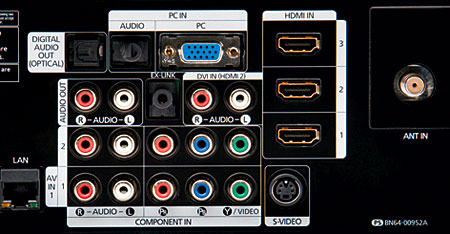Ok, if the date is correct on this review what is the purpose of it?
Samsung LN55A950 LCD TV Setup & Tests
Setting the correct black level is among the first and most important steps necessary to properly adjust a new TV. It's usually no big deal to do this—you simply tweak the TV's brightness control while viewing a PLUGE test pattern, which in its simplest form consists of a black background with two vertical stripes, one slightly lighter than black (above black) and the other slightly darker than black (below black). The TV's black level is correct when the below-black stripe disappears into the background, while the above-black stripe remains visible.

My initial attempts to set the Samsung's black level were frustrated by the set's LED SmartLighting function, which insisted on dragging dimly lit areas on an otherwise blank screen down to total blackness. In the case of the PLUGE test pattern, the stripes would appear for a second or two, then fade away, leaving nothing but a blank, pitch-black screen. I ended up setting the level by eye, using regular program material, but I was never entirely comfortable with the results.
A few days later, Samsung informed me that my early production sample had been shipped with an incorrect setting in the service menu, which was causing LED SmartLighting to behave too aggressively on scenes with low average picture level (APL). (Samsung has assured us that all sets manufactured after late September ship with updated hardware and the correct setting, so you should not run into the same problem.)
With the right service-menu setting, the PLUGE pattern seemed to display correctly. I say "seemed" because when I adjusted the black level so the PLUGE pattern looked right, I experienced some significant problems in certain low-APL program material. I was only able to resolve these problems by tweaking the black level slightly higher than the "correct" setting. At least on my sample, the exact setting was critical—it had to be 63, not one click higher or lower, or the picture really suffered. I'll have more to say on this in the Real-World Performance section of this review.
On the other end of the light-output range, whites begin to clip at contrast settings above about 90. I ended up reducing the level to 85.
In the Warm2 color-temp setting, the grayscale was very close to the D65 standard throughout the brightness range. The only significant deviation was at the darkest level of 20 IRE. I was able to improve this somewhat using instrumentation, but all I did was gild the lily. If you can afford this TV, you can probably afford to have it professionally calibrated, but it doesn't require much work to look its best.
The color primaries also measured almost perfect right out of the box—simply select the Auto color mode and you're golden. I was able to make slight improvements using a color analyzer to tweak the Color Space controls, but the improvements were subtle and hardly seemed worth the effort. In the end, I was able to get all the color points spot on except yellow, which could not be pushed quite far enough toward red. Interestingly, this color-management system provides red, green, and blue level adjustments for each primary and secondary color, rather than the more conventional tint, saturation, and brightness controls for each color.
Turning to the test material on the HQV Benchmark Blu-ray at 1080i, the noise test revealed that the Samsung's DNR (digital noise reduction) circuit makes a slight but noticeable difference without overly softening the picture. I usually leave it in the Medium position. The video resolution-loss test looked perfect, with no visible jaggies or flickering. The film resolution-loss test also looked perfect when Auto Motion Plus (AMP) frame-interpolation was turned off—turning it on caused some smudging artifacts to appear in the high-frequency vertical bursts, though it also improved detail in the pan across the bleachers.
Samsung's AMP frame interpolation proved its mettle in the fast-moving torture-test scenes on the FPD Benchmark Blu-ray. Other than a few fleeting artifacts in one scene, this is easily the best frame-interpolation implementation I've seen to date. Minute detail on fast-scrolling material remained so flawless and crystal clear, I thought I was watching a plasma, not an LCD—and a Pioneer Kuro plasma, at that!
On the HQV Benchmark DVD at 480i via component, the Samsung's video processor never broke a sweat when pushed to the limits. All the jaggies tests looked fantastic, with nary a zigzag edge to be seen. Detail looked as good as 480i can ever look. I did see a mild motion trail behind the roller coaster, regardless of the AMP setting. The set locks onto 3:2 pulldown after a few frames. On the mixed-cadence tests, 2:2 looked fantastic. The video-text-over-film test was all torn up when the Film Mode control was set to Auto1, but it looked perfect in Auto2, so that's where I left it.
- Log in or register to post comments




































































